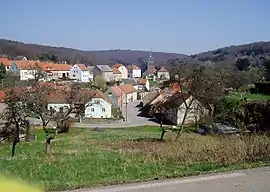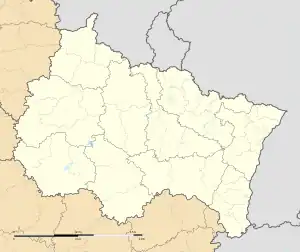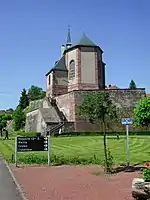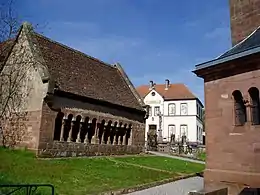Schorbach | |
|---|---|
 A general view of Schorbach | |
 Coat of arms | |
Location of Schorbach | |
 Schorbach  Schorbach | |
| Coordinates: 49°04′48″N 7°24′24″E / 49.08°N 7.4067°E | |
| Country | France |
| Region | Grand Est |
| Department | Moselle |
| Arrondissement | Sarreguemines |
| Canton | Bitche |
| Intercommunality | CC du Pays de Bitche |
| Government | |
| • Mayor (2020–2026) | Paul Dellinger[1] |
| Area 1 | 13.36 km2 (5.16 sq mi) |
| Population | 533 |
| • Density | 40/km2 (100/sq mi) |
| Time zone | UTC+01:00 (CET) |
| • Summer (DST) | UTC+02:00 (CEST) |
| INSEE/Postal code | 57639 /57230 |
| Elevation | 273–413 m (896–1,355 ft) (avg. 415 m or 1,362 ft) |
| 1 French Land Register data, which excludes lakes, ponds, glaciers > 1 km2 (0.386 sq mi or 247 acres) and river estuaries. | |
Schorbach (French pronunciation: [ʃɔʁbak]) is a commune in the Moselle department of the Grand Est administrative region in north-eastern France.
The village belongs to the Pays de Bitche. As of 2013 Schorbach had 551 residents. The residents refer to themselves as Schorbachois, and are also known by the sobriquet Wurschtfresser, a name that refers to the annual Wurschtfescht (sausage feast) that is celebrated on Saint Rémi's day.[3]
Geography
Schorbach is a few kilometres South of the border with the Palatinate (Germany), North-east of Bitche. The commune is part of the Palatinate Forest-North Vosges Biosphere Reserve.
History
The name Schor-Bach, probably meaning turtle-stream, is first seen in 1210. The place was long part of Zweibrücken-Bitsch.
Schorbach was an early seat of a church congregation, served by the Hornbach monastery, and until the French Revolution it remained the central church for the surrounding villages.
At the start of World War II, the inhabitants were evacuated to the Département of Charente. Schorbach was liberated by American troops on the 16th of March 1945.
Population
| Year | Pop. | ±% p.a. |
|---|---|---|
| 1968 | 694 | — |
| 1975 | 695 | +0.02% |
| 1982 | 636 | −1.26% |
| 1990 | 649 | +0.25% |
| 1999 | 621 | −0.49% |
| 2007 | 589 | −0.66% |
| 2012 | 559 | −1.04% |
| 2017 | 540 | −0.69% |
| Source: INSEE[4] | ||
Culture
The church of Saint Rémi, built on the site of a previous church inaugurated in 1143, on a rock overlooking the town, was the central parish church of the Pays de Bitche for many centuries. The founder of the church is unknown, but local history frequently ascribes the foundation to Berthold von Eberstein, whose son Eberhard III resigned his right of patronage at the nearby Sturzelbronn abbey. Eberhard's daughter married Count Henri II of Zweibrücken-Bitsch.
A square tower survives from the time of the foundation of the church, but the nave is Gothic. In 1774 the church, which had fallen into ruin, was comprehensively restored.
Schorbach is also known for the Ossarium at the entrance of the old churchyard, which dates from either the 12th[5] or 15th[6] century, according to different sources.
 Church of Saint-Rémy |
 Roman Ossarium |
References
- ↑ "Répertoire national des élus: les maires". data.gouv.fr, Plateforme ouverte des données publiques françaises (in French). 2 December 2020.
- ↑ "Populations légales 2021". The National Institute of Statistics and Economic Studies. 28 December 2023.
- ↑ Un sobriquet du pays de Bitche in Les Cahiers Lorrains, n°3, 1960.
- ↑ Population en historique depuis 1968, INSEE
- ↑ Franz Xaver Krauss, Kunst und Altertum in Elsass-Lothringen, tome III, Strasbourg, 1889.
- ↑ Marie-France Jacops, Jacques Guillaume, Didier Hemmer: Le Pays de Bitche (Moselle), Inventaire général des monuments et des richesses artistiques de la France, Région Lorraine, Ed. Serpenoise, Metz, 1990 (p.121).
External links
- Schorbach at bitscherland.fr (French)
